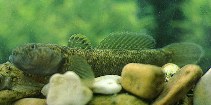| Family: |
Gobiidae (Gobies), subfamily: Gobiinae |
| Max. size: |
12.5 cm TL (male/unsexed); 7 cm TL (female) |
| Environment: |
demersal; freshwater |
| Distribution: |
Europe: Central Italy (Tevere, Arno and Ombrone drainages) on Tyrrhenian slope. |
| Diagnosis: |
Vertebrae: 29-30. Head canals present, including anterior and posterior oculoscapular and preopercular canals; no interorbital papillae; typically D2 I/11-12 (Ref. 12215). This species is distinguished from other gobies in freshwaters of Adriatic basin and western Italy by the following characters: presence of cephalic lateral line canals; branched rays in second dorsal 11-12.5; scales in midlateral series 44-49; completely scaled caudal peduncle (Ref. 59043). |
| Biology: |
Found only in freshwater, in shallow, well vegetated shores of small to medium-size streams with moderate flow (over pebble beds, Ref. 26100). Spawns from the first time at 1 year; in May to June; females may repeat spawning during this season. Adhesive eggs deposited between stones, shells and aquatic plants and males guard the eggs until hatching. When spawning and defending the nest, males produce sounds (Ref. 59043). Exhibits territoriality during breeding season. Feeds on a wide variety of invertebrates. A short-lived species which is threatened due to habitat destruction and pollution. (Ref. 26100). |
| IUCN Red List Status: |
Vulnerable (VU); Date assessed: 31 January 2006 (B2ab(ii,iii,iv,v)) Ref. (130435)
|
| Threat to humans: |
harmless |
Source and more info: www.fishbase.org. For personal, classroom, and other internal use only. Not for publication.

